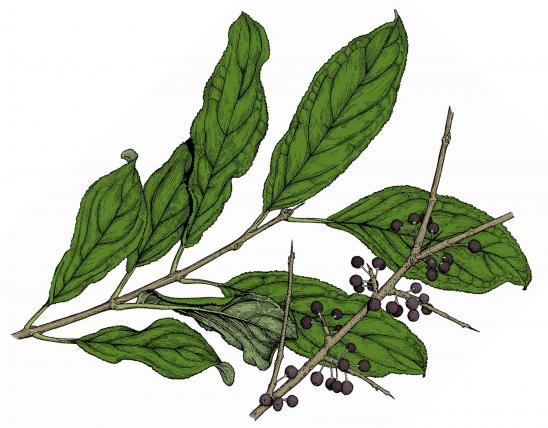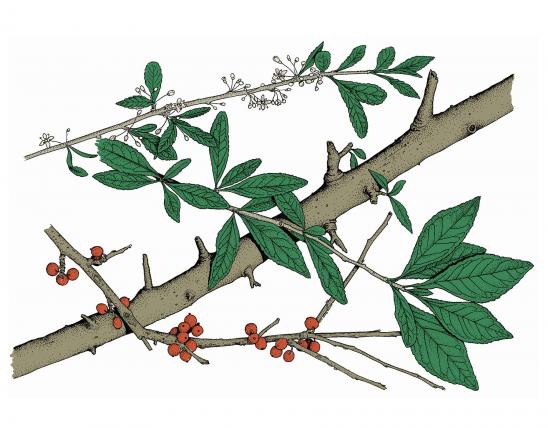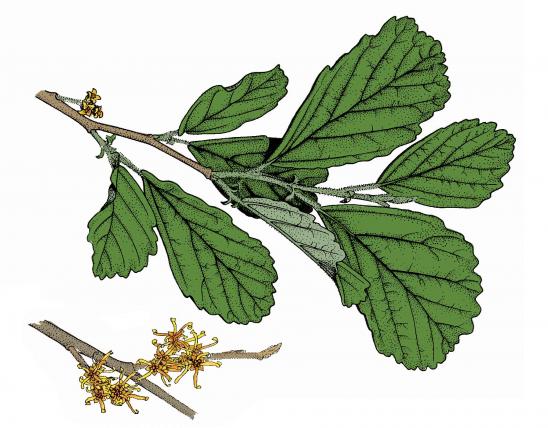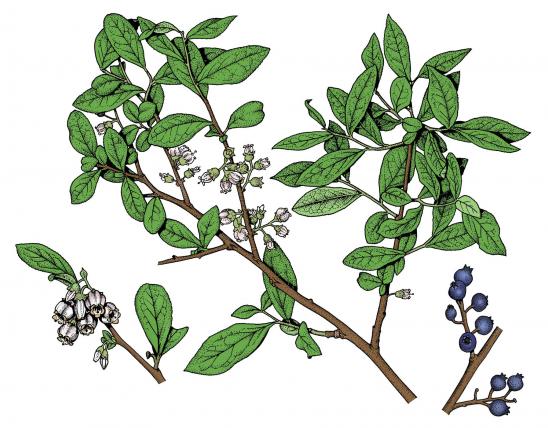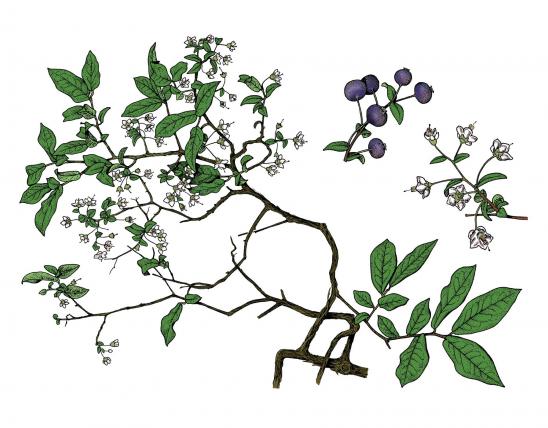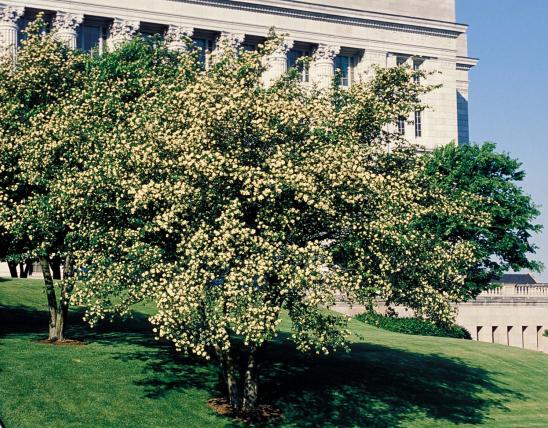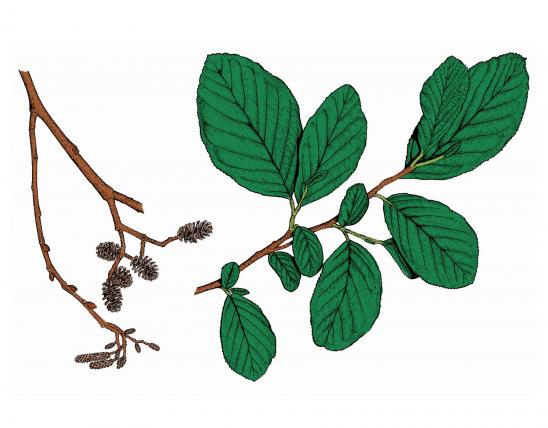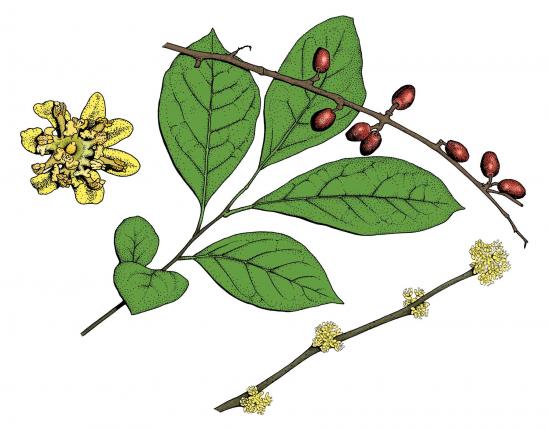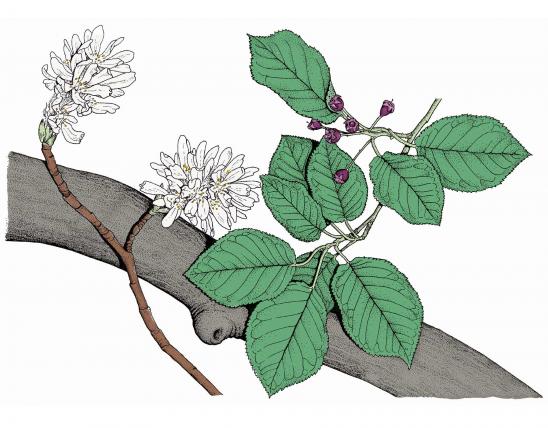
Carolina buckthorn occurs in the southeastern half of Missouri. It’s a shrub with several main stems, or a small tree potentially reaching 40 feet high with a trunk diameter of up to 8 inches. Despite the name, there are no thorns.
Leaves are simple, alternate, scattered along the branches; blade 2–6 inches long, 1–2 inches wide, narrow at the ends and broadest in the middle, tip pointed, base wedge-shaped to rounded, margin slightly toothed, rather thin; upper surface bright green, smooth, shiny, sometimes hairy; lower surface velvety hairy to only slightly hairy or smooth; leaf blades usually with 4–10 veins on each side of the central vein; the leaf stalk is slender, about ¼–½ inch long, widened at the base, smooth or hairy. The leaves turn yellow to yellowish orange in autumn and often last into winter.
Bark is gray to brown, sometimes blotched, smooth, with shallow grooves.
Twigs are slender, young ones green to reddish, later gray; hairy at first, smooth later; sometimes terminating in a cluster of very small folded leaves; buds naked, not covered by scales, densely hairy, slender, elongated.
Flowers May–June; these occur singly or in clusters of 2–10, arising from leaf axils; flowers are small, greenish yellow, with 5 minute petals having pointed tips; stamens 5, alternating with the petals.
Fruits August–October; these are berries that persist into winter; sweet, round, about ¼ inch in diameter, red at first, turning black and shiny, at maturity usually 3-seeded; seeds reddish brown.
Similar species: Five species of buckthorns (Rhamnus spp.) have been recorded in Missouri. Many botanists separate Carolina buckthorn (plus several species that don’t occur in Missouri) into a separate genus, Frangula, based on several differences in form: lack of thorns; naked winter buds; leaf blades with pinnate, rather straight secondary veins; perfect flowers (that have both female and male organs functioning); and seeds having a terminal, beaklike projection but lacking a lengthwise furrow. Even if they are considered separate genera, the two groups of buckthorns are recognized as being closely related, however.
Lanceleaf buckthorn (R. lanceolata), a native species, is scattered statewide, but apparently absent from the Bootheel lowlands. It is sometimes mistaken for deciduous holly, or possum haw (Ilex decidua). Like Carolina buckthorn, lanceleaf buckthorn is a thornless shrub with mostly alternate leaves; however, lanceleaf buckthorn has leaves with mostly 4–7 (not 6–11) pairs of secondary veins; imperfect flowers (flowers have either stamens or pistils, not both); 4 (not 5) petals and 4 (not 5) sepals; with the styles 2-branched at the tip. Also, the winter buds have several overlapping scales (not scaleless). Most noticeable when in bloom; otherwise an easily overlooked species. Missouri is about at the center of this species’ worldwide range.
The other three buckthorns recorded in Missouri are nonnatives with mostly opposite leaves and branches that are thorn-tipped. These nonnative, Asian buckthorn species are the overwintering hosts for the soybean aphid, Aphis glycines, a serious pest of soybean crops that requires both buckthorn and soybean plants to complete its life cycle:
- Common buckthorn, or European buckthorn (R. cathartica) is a nonnative, invasive species most common in the eastern half of the state. Sometimes cultivated as a shrub. Native of Eurasia that spreads aggressively and forms impenetrable thickets. As with common, Japanese, and Dahurian buckthorns, another reason it is not recommended is that it is one of the hosts for the soybean aphid.
- Japanese buckthorn (R. japonica) is another nonnative species that can be cultivated as a shrub; as with common and Dahurian buckthorns, it is not recommended as it is known to escape from cultivation and is one of the hosts for the soybean aphid.
- Dahurian buckthorn (R. davurica) is another nonnative species that can be cultivated as a shrub; as with common and Japanese buckthorns, it is not recommended as it is one of the hosts for the soybean aphid.
Finally, a sixth buckthorn may potentially be seen in Missouri: Glossy false buckthorn, alder buckthorn, or black buckthorn (Frangula alnus or Rhamnus frangula) is a native of Europe. Like our native Carolina and lanceleaf buckthorns, it lacks thorns and has alternate leaves. And like Carolina buckthorn, it has scaleless (naked) winter buds, and flowers with 5 petals and 5 sepals. Glossy false buckthorn is distinguished by its shorter leaves (only to about 3 inches long), with the blades mostly less than twice as long as wide (as opposed to 2 or 3 times as long as wide), and with the margins toothless or at most with only a few, tiny teeth near the tip. The flower stalks and bases of the flowers are glabrous (not hairy). Also, it is an aggressive, nonnative invader that is widely naturalized in the United States and may possibly be found in natural habitats in Missouri, especially in northern Missouri wetlands. Introduced to our continent as an ornamental shrub. Several cultivars, with different growth habits and leaf forms, exist. It is not recommended for planting. Instead, try native buckthorns, witch-hazels, blackhaw viburnum, or black chokeberry.
Note that some shrubs in a different family are also called buckthorns; these are members of genus Sideroxylon (syn. Bumelia), in the sapote family (Sapotaceae). In Missouri, two species occur: Gum bumelia, woolly buckthorn, chittim wood, or false buckthorn (S. lanuginosum); and buckthorn bumelia, southern buckthorn, ironwood, or smooth bumelia (S. lycioides). Both have milky sap and leaves that are widest at or above the middle, lacking teeth. The flowers have an odd appearance: the stamens appear to be sandwiched between 2 whorls of petal lobes; the inner whorl, however, is actually composed of flattened, petal-like, sterile stamens.
Height: usually to 6 to 16 feet; occasionally up to nearly 40 feet.
Scattered in the southeastern half of Missouri, occurring in the Ozarks and Ozark border and in the Crowley’s Ridge and Sikeston ridge portions of the Mississippi lowlands.
Habitat and Conservation
Occurs in moist to dry upland forests, banks of streams and rivers, glades, and ledges and tops of bluffs; also along roadsides. Look for it in low woodlands in valleys along streams, rocky open wooded slopes, upland ridges, thickets, and glades.
Status
Native Missouri shrub or small tree. A good native shrub for landscaping, offering beautiful shiny green leaves in summer and golden and orange foliage in fall.
Human Connections
The attractive leaves and fruit make Carolina buckthorn a good candidate for woodland plantings. The yellow and yellow-orange autumn foliage is another plus. The Missouri Botanical Garden has named Carolina buckthorn as a Plant of Merit, marking it as highly recommended for Missouri and nearby areas. Among its virtues are its hardiness, disease resistance, and high ornamental value. Suggested uses include as a hedge, privacy screen, windbreak, or backdrop for perennials; it can also be naturalized among other native plants.
Carolina buckthorn and other buckthorns are alternate hosts for crown rust (or leaf rust) of oats (Puccinia coronata var. avenae). On oats, this fungal disease causes brown spots on leaves and shriveled grain, reducing yield and value. Thus buckthorns are not recommended for planting in areas where oat crops are grown.
The wood is hard, brittle, and of no value commercially because of the shrub or tree’s usually small size.
The fruit is sweet and considered edible by some, but others know it for its ability to cause vomiting. The berries’ use by Native Americans accounts for the plant’s other common name, Indian cherry.
Native Americans used bark tea to induce vomiting; it is also a strong laxative. The fruit and bark will cause diarrhea and vomiting.
Ecosystem Connections
The fruit is eaten by several species of birds, notably by gray catbirds and pileated woodpeckers, but also a variety of fruit-eating birds such as robins, waxwings, and grosbeaks. Mice and other small mammals apparently eat the seeds. White-tailed deer browse the twigs in winter.
The flowers are not too exciting for people, but many types of bees, wasps, flies, beetles, and other insects visit them for pollen and nectar.
Buckthorns are the caterpillar host plants for certain types of moths and butterflies. Of these, certain species may be limited to buckthorns, while others may include buckthorns among a wide variety of possible host plants. Among the generalist butterflies that use buckthorns are the gray hairstreak, spring azure, and Henry’s elfin.
When you choose native plants for landscaping, you help to expand the amount of native habitat that can be used by animals, thus helping offset the habitat loss and degradation caused by human agriculture, urban, and suburban developments.
























